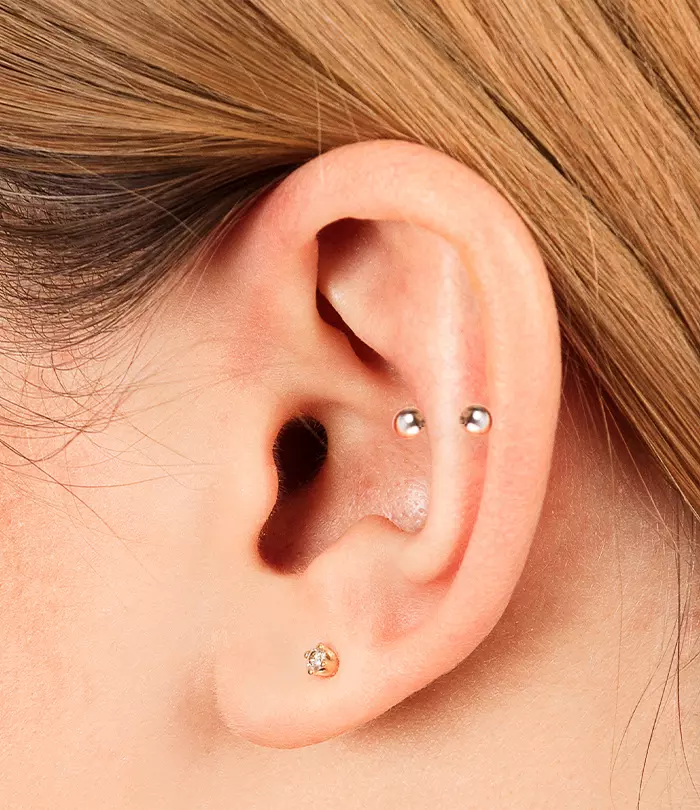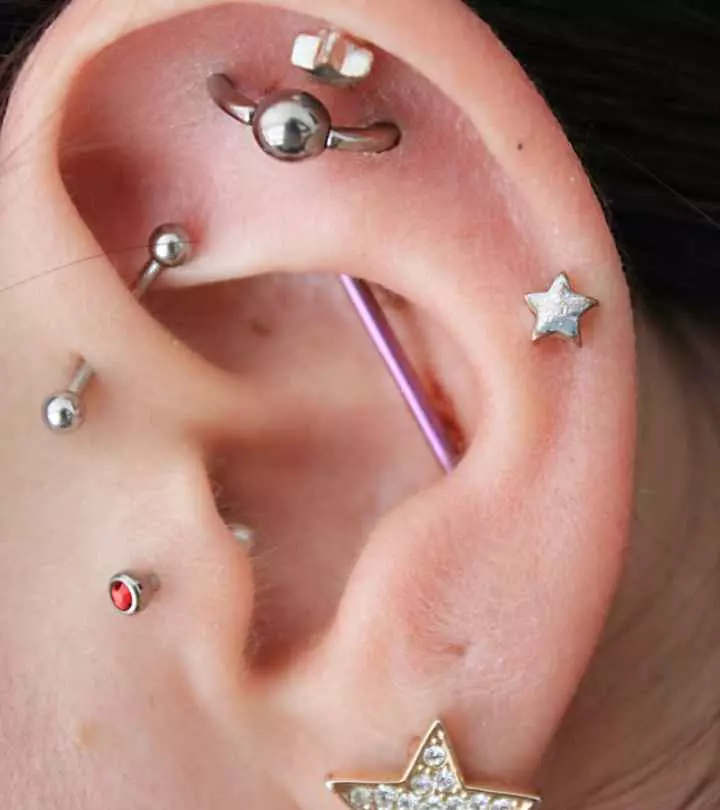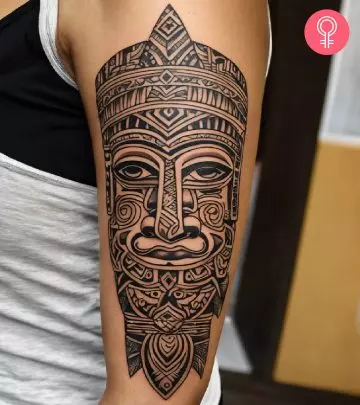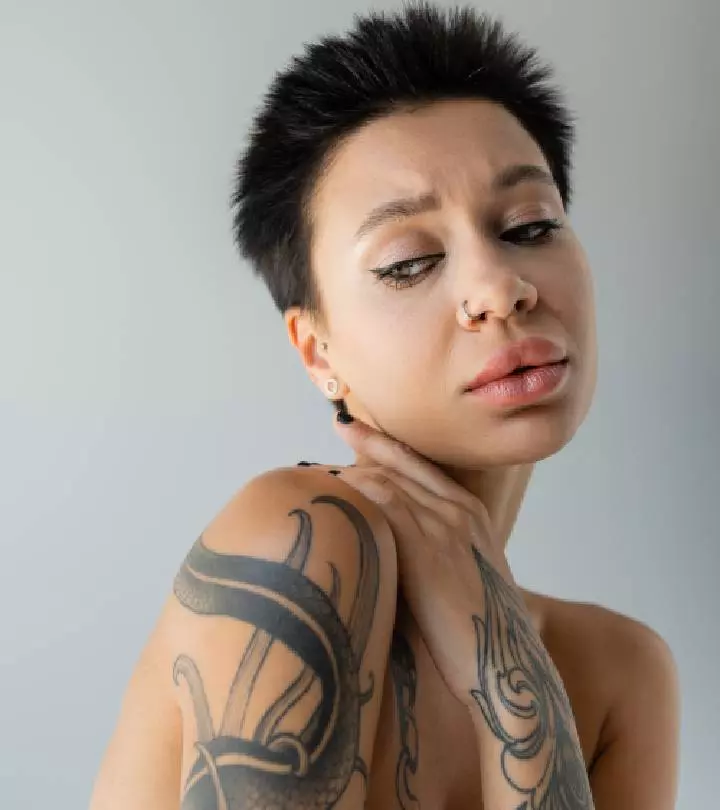Rook Piercing: Pain Level, Benefits, Cost, & Side Effects
Elevate your look with a stunning piercing that lets your bold side shine!

Image: Shutterstock
Rook piercings have become popular recently, owing to their stylish placement that sits beautifully on the so-called “shelf” of the ear. Nestled in the upper part of the ear’s cartilage, a rook piercing adds a touch of individuality to the overall look of a person. Unlike traditional earlobe piercings, a rook piercing involves a small and strategic perforation through the cartilage fold that creates a distinctive look.
This type of piercing is versatile and can be used to showcase various types of jewelry, from subtle studs to intricate hoops. Whether you are a piercing enthusiast or a first-timer, you can rock a rook piercing with ease. Keep scrolling to learn all about this contemporary piercing, from the pain level and piercing cost to the healing period and benefits. Keep reading!
 Piercing Guide: Rook Piercing
Piercing Guide: Rook Piercing- Placement: Upper part of the ear cartilage
- Best Jewelry: Subtle studs, stylish hoops, curved barbells
- Cost: $40 to $80
- Pain Level: Medium
- Healing Time: 6 to 12 Months
In This Article
What Is A Rook Piercing?
View this post on Instagram
Whenever we talk about cartilage piercing types, jewelry, there is no way Rook piercing doesn’t get its mention. A rook piercing is a trendy cartilage piercing done on the inner ridge fold of the upper ear fold, diagonally above a daith placement. The cartilage at the ear is pierced horizontally, dividing the inner and outer sections of the ear. The procedure typically involves marking the entry and exit of the piercing holes and inserting the needle freehand. A 14-16g needle is commonly used for the process that allows for quick insertion and minimal pain.
If you are thinking about getting it done, opt for a skilled piercer, with years of experience under their belt, who uses sterilized equipment and keeps their workplace clean. This reduces the risk of mistakes and infections. Amateur piercers may pierce the ear incorrectly, leading to a damaged hole and pain.
 Trivia
TriviaNow that we are aware of the meaning of it, let’s instantly talk about its main factor, the level of pain it can cause. Scroll down to know more.
Key Takeaways
- Rook piercing refers to the piercing placed in the upper ear fold and is done on the thick cartilage.
- Its healing period can last between 6 months to 1 year.
- The common types of jewelry used with rook piercings are barbells, hoops, and studs.
- The piercing can cost anything between 40 to 80 dollars, plus separate charges for the jewelry.
- Keep proper aftercare practices in mind when getting a fresh rook piercing, such as, avoid direct sunlight, use salt solution, avoid swimming pools, and wear relaxed clothes.
Rook Piercing Pain Level
While every type of piercing comes with a pinch, the rook may be more painful than the rest. The piercing is done through the dense cartilage layer that brings discomfort and mild soreness to the ear. The cartilage is made of hard avascular tissues that take longer to heal and feel sharper pain. An intense pressure can be felt during the piercing process, followed by a throbbing sensation. Like every piercing, your ears may ache and you may find it difficult to sleep. However, the level of pain also depends on an individual’s personal tolerance level. But if you feel continued discomfort and aching even after 2-3 weeks, then it is ideal to check for infection.
Since rook piercings need more pressure to penetrate compared to softer tissues, because of the thick cartilage in the area, they are often reported to be painful. The pain level of a rook piercing is often rated at a 6 on a pain scale of 1 to 10.
Sabrina, a blogger, talks about her personal encounter with a fresh rook piercing in her blog post. She recounts her experience and states, “But the rook piercing was actually not nearly as painful as I was expecting. It’s mostly just a feeling of extreme pressure, more than a stabbing pain. Though my hands and feet did express a fair bit of anguish, I managed to keep my head and face still (i).”
Continue scrolling as we talk about the symptoms of an infected rook piercing.
What Does An Infected Rook Piercing Look Like?
An infected rook piercing may exhibit redness, swelling, and discharge. If left untreated, it may lead to prolonged pain, warmth, a foul odor, and even fever in some cases. It is advised to cleanse the infected area with a saline solution and consult a doctor for a proper treatment plan. There are certain causes that may lead to an infected rook piercing. The common causes include poor aftercare, submerging the piercing in unclean water, using a pool during the initial healing stage, using harsh cleaning solution, and wearing tight jewelry. Avoiding these can help lower the risk of an infected rook piercing.
One common sign that something is wrong with your rook piercing is that it takes more time to heal than normal. You may be wondering what is the usual time of healing as well and how long should one expect for proper healing, learn all about it below.
How Long Does It Take For A Rook Piercing To Heal?
View this post on Instagram
Rook piercing healing generally spans 6-12 months and can take even longer as the cartilage area receives less blood flow. You may notice some initial soreness and redness during the primary healing stage that lasts for the first 2 to 3 weeks. Then, the hurt tissue matures, causing occasional mild discomfort for a few months. Finally, at the end of the healing period, the piercing should feel stable and comfortable.
 Trivia
TriviaBut besides the healing process taking its good amount of time, the piercing carries various benefits too, check them out below!
Benefits Of A Rook Piercing
View this post on Instagram
This statement piercing brings a lot of benefits along with it as well. It is a trendy ear cartilage piercing that promotes individuality; its versatility allows for numerous jewelry options. But besides offering a stunning aesthetic appeal, it has some therapeutic advantages as well.
Rook Piercing For Migraines: According to anecdotal evidence, getting a rook piercing for migraines can aid in combating chronic headaches and provide some relief.
Rook Piercing For Anxiety: While there is no scientific research backing the claim of rook piercing for anxiety, many individuals seek it as a grounding, self-expression method amid anxiety and stress.
But while we have covered the benefits of it, there are some side effects one should be aware of as well. Scroll down to know more about it.
Side Effects Of A Rook Piercing
- Soreness:You may experience mild discomfort and soreness post a new rook piercing. Ensure to use an ice pack to relive the tenderness.
- Swelling: Noticeable swelling is common during the initial healing stage (1). However, prolonged inflammation can be concerning and it is recommended to consult a professional in such cases.
- Irritation Bumps: Small, raised bumps near the rook piercing may be noticed during the initial healing process, indicating infection (2).
- Risk Of Infection:Improper aftercare and sterilization measures can lead to the risk of bacterial or fungal infection (3).
- Risk Of Keloid Formation: Rook piercing can also result in raised and thickened tissues and cause keloid scars (4), (5).
- Discharge: You may experience minor skin infection during the healing stage that leads to a slightly creamy or yellow discharge.
- Extreme Warmth:Unusual warm or heat sensation around the piercing area can indicate inflammation or skin infection.
- Rejection: Certain individuals may experience rejection with a new rook piercing with the body subtly pushing the jewelry out. This occurs as a natural response of the skin in keeping foreign objects out or due to improper placement.
It is important to be aware of these side effects of this popular cartilage piercing before booking an appointment for it. But if you have decided on getting it, then scroll down as we read about its cost.
How Much Does A Rook Piercing Cost?
View this post on Instagram
The cost of a rook piercing may change depending on factors like the reputation and location of the piercing studio or artist and the jewelry quality. However, you can expect the average cost to be between 40 to 80 dollars for the piercing itself, excluding the price of the jewelry.
But after getting the beautiful adornment you need to follow the right aftercare tips to ensure that it heals properly and learn simple yet effective ways of cleaning the fresh ear piercing. Scroll down and check out the section below.
How To Clean A Rook Piercing
Thoroughly and effectively cleaning of the new ear piercing is crucial to prevent possible skin infections. There are certain aftercare instructions you can keep in mind as well, such as:
- Clean the new piercing with a store-bought or homemade saline solution twice daily.
- You do not need to rotate the jewelry during cleaning.
- Use a clean paper towel submerged in saline water to wipe the area.
- Pat dry with a clean paper towel and not cloth.
- Religiously apply any ointment recommended by the piercer or doctor to speed up the healing process.
- Avoid direct sun exposure, especially during the initial healing stages, as you cannot wear sunscreens then since they contain ingredients that may dry out your skin.
- Indulge in a sea salt bath once or twice daily.
- Avoid touching the piercing with dirty hands.
- Keep hair products away from the pierced area.
- Avoid swimming pools and hot tubs during the initial healing period.
- Wear loose-fitting clothes that do not snag on or tug at the ear piercing.
- Refrain from removing the jewelry until the piercing is completely healed.
Aftercare is essential to avoid infection and ensure appropriate healing. Not following the aftercare tips recommended by your tattooist may result in problems like infection and chronic pain that are often more severe for cartilage piercings.
Sabrina, the blogger, further continues sharing her piercing experience and talks about the complete cleaning process. She states, “When I can, I try to clean my piercing four times a day. Usually, two sea salt soaks a day, and then I’ll use Bactine in the morning and at night (i).”
After the healing stages are complete, you may wish to remove the initial jewelry piece and wear something else. At this point, reading a piece on ‘When can I change my ear piercing?’ can help you achieve the transition smoothly. The same goes for the Rook piercing. Let’s understand how you can effortlessly and safely remove the Rook piercing and replace it with a trendy piece.
How To Remove A Rook Piercing
You should learn how to remove your rook piercing from an expert piercer. They will show you the right technique and how gentle you need to be. Begin by sterilizing the earring and your hands using rubbing alcohol. Then, softly squeeze the hoop with your thumb and the forefinger until the small latch pop opens. Once the latch is open, slide the earring out of the earlobe and clean the area with a paper towel.
Now, once you have removed the earring you may want to experiment with something trendy and appealing but what type of jewelry is most ideal for this placement? Scroll down to know more!
Rook Piercing Jewelry
Rook piercings accommodate three primary jewelry types that look ever-so beautiful on the upper cartilage placement. These are, hoops, studs, and barbells.
- Hoops: The hoop or rook ring jewelry is one of most commonly-used jewelry, due to its simple installation and easy replacing nature.
- Studs: Stud rook earrings are akin to barbells but differ with a flat back surface instead of beads and consist of a single piece.
- Barbells: A straight barbell is often used but recently curved barbells have also become a popular alternative featuring removable beads.
There are different types of jewelry you can opt for a rook piercing. It is also important to learn some tips that will help you choose the right material and size of the jewelry.
- Opt for hypoallergenic materials like titanium or surgical steel to minimize the risk of allergic reactions.
- You can also opt for silver, gold, or white gold jewelry pieces that are of high-quality material and hypoallergenic.
- It is generally recommended to avoid nickel jewelry, as it is a common allergen.
- As for the size, consider your personal preference and comfort both. Choosing a piece that offers a snug fit and is of minimalist aesthetics is always better.
But if you are not entirely sure about these jewelry options and wish to look at some appealing references then scroll through!
1. Double Ring Rook Piercing
View this post on Instagram
This unique design involving two small hoops placed in the cartilage of the upper ear is a stylish and unconventional look. The trendy piercings enhance the rook area’s aesthetic appeal and provide a subtle yet eye-catching adornment. It is the ideal jewelry for those who wish to express their individuality but like to stick to minimalists and alluring pieces.
2. Curved Diamond Barbell Rook Piercing
View this post on Instagram
This stunning rook piercing with curved barbell and double diamond jewelry is one you cannot go past without bookmarking! While the barbell piece offers the most comfort and ease to the wearer, especially first-timers, the diamond design increases the aesthetic quotient of the jewelry and overall ear. It exudes sophisticated elegance and can be a fashionable choice for those seeking a chic accessory.
3. Rook Piercing With Emerald Barbell Earring
View this post on Instagram
This is another barbell rook piercing design we cannot get enough of! The piece radiates pure grace and luxury. The piercing showcases a delicate curvature that makes the ear, and you, ever-so-edgy. The intricacy of this rook piercing design here allows for creative combinations and stacking. The shimmering gem nestled on top of the barbell jewelry adds a touch of sophisticated glamor.
4. Bat Design Curved Barbell Rook Piercing
View this post on Instagram
This bat barbell rook piercing offers an avant-garde fusion of edginess and elegance. The jewelry piece features a unique bat motif that adds a touch of mystique to the ear. The curved barbell will instantly complement your anatomy and seamlessly become a part of the body adornment. The overall ear aesthetic also lets you portray your individuality and daring soul.
5. Minimalist Crystal Rook Piercing Hoop
View this post on Instagram
A subtle blend of sophistication and charm, this delicate rook hoop with a single sparkling crystal is ideal for anyone looking for a jewelry piece that oozes timeless elegance. The minimalist piercing offers an understated yet radiant refinement, making it perfect for those seeking a graceful piece to add to their jewelry collection. So, without much contemplation definitely go ahead and bookmark this reference for the future!
Rook piercings offer a distinctive way to express your individual style through a variety of jewelry options, such as, barbells, studs, and hoops. The initial piercing choice, whether a straight or a curved bar, sets the tone for your aesthetic journey. The strategic location of the rook piercing in the upper layer of cartilage provides an unconventional touch to your look. Rook piercings have become highly sought-after now, attracting both piercing aficionados and newcomers who are keen on sprucing up their ear look.
Frequently Asked Questions
What gauge is a rook piercing?
Rook piercings commonly use a 16-18 gauge but the size may also vary depending on personal preference and piecer recommendation.
Can you sleep on a new rook piercing?
Avoid sleeping directly on a new rook piercing. Opt for a travel pillow or any other soft surface that leaves some room for the ear.
Can anyone get a rook piercing or are there restrictions?
Rook piercings are generally accessible to the majority of individuals, however, it is recommended only if you are above the age of 18 or 16 with parental consent.
If getting your ear adorned with a rook piercing has been on your mind lately, then check out the video below that delves deep into the topic, from talking about the correct angle, healing time and more to recommended jewelry types!
Personal Experience: Source
StyleCraze's articles are interwoven with authentic personal narratives that provide depth and resonance to our content. Below are the sources of the personal accounts referenced in this article.
(i) One Week With A Rook Piercing
https://silverscreened.wordpress.com/2012/08/24/one-week-with-a-rook-piercing/
References
Articles on StyleCraze are backed by verified information from peer-reviewed and academic research papers, reputed organizations, research institutions, and medical associations to ensure accuracy and relevance. Read our editorial policy to learn more.
- Complications Of Body Piercings: A Systematic Review
https://cdn.mdedge.com/files/s3fs-public/CT112003139.pdf - “High” Ear Piercing And The Rising Incidence Of Perichondritis Of The Pinna
https://www.ncbi.nlm.nih.gov/pmc/articles/PMC1120071/ - Risk Factors For Cartilage Infections Of The Ear
https://www.researchgate.net/publication/7594624_Risk_Factors_for_Cartilage_Infections_of_the_Ear - Ear-Piercing Complications In Children And Adolescents
https://www.ncbi.nlm.nih.gov/pmc/articles/PMC9470180/ - Trends And Complications Of Ear Piercing Among Selected Nigerian Population
https://core.ac.uk/download/pdf/143491296.pdf
Read full bio of Rodrigo Casco
Read full bio of Pahul Nanra
Read full bio of Anjali Sayee
Read full bio of Aparna Harry


























Community Experiences
Join the conversation and become a part of our empowering community! Share your stories, experiences, and insights to connect with other beauty, lifestyle, and health enthusiasts.